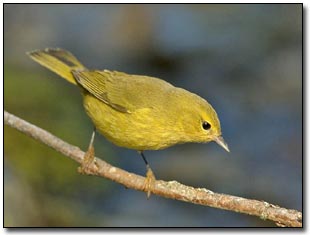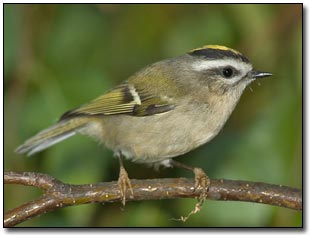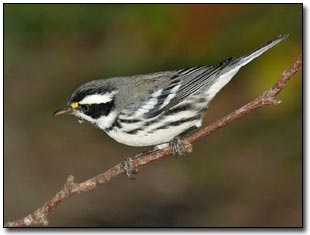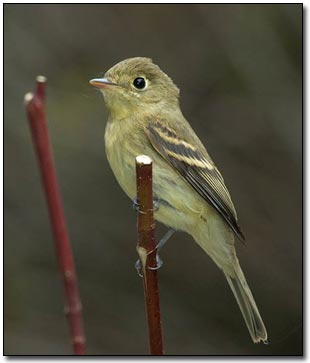|
Bird photography is a constant challenge since the subject is usually small,
may not stay still, moves rapidly from branch to branch, sits in less than favorable lighting conditions and is extremely aware of an approaching photographer. So, as we all can see, bird photography can be
 frustrating as well as rewarding.
frustrating as well as rewarding.
1. It is always better if you can get as close as possible to your subject; i.e. the closer the better. Some subjects are easier than others to get close to. For those that are not so easy, you need to devise a method for getting closer, or bringing them to you. Feeders are a bit of a problem as no one wants feeders or bird seed in their photos. What I do is setup perches around my feeding stations. Many birds will land on the perches before going to the feed. For birds the size of sparrows or warblers, I usually try to be within 10 to 20 feet.
2. Use a blind or hide whenever you can. I used to just go around taking pictures of any birds I could find while looking for them. When I started using a blind I realized that the birds could be themselves with me close by and therefore made photography much easier. Sometimes just sitting in a blind
 anywhere can produce amazing results. My blind by my feeders and creek & pond have produced more good close photos than anywhere else. Plus I always take my blind with me when I travel and use it whenever the situation calls for it. Most top bird photographers use blinds. Use a car as a blind when ever possible.
anywhere can produce amazing results. My blind by my feeders and creek & pond have produced more good close photos than anywhere else. Plus I always take my blind with me when I travel and use it whenever the situation calls for it. Most top bird photographers use blinds. Use a car as a blind when ever possible.
3. Always use a tripod unless the situation doesn't allow for it. It took me years to learn this lesson. Since I got my new DSLR setup I almost always use a tripod. It just makes it that much more sure that you will get a good sharp image.
4. Spend lots of time studying and learning about your subjects. I spent many years with some of the top birders around here to get to know where to find certain species. When spending lots of time around the various species, you get a more intimate understanding of their habits and tolerance. Some birds are much more tolerate of human interaction than others. Getting to know them also helps in your attempts to close in on them for photos.
5. Be prepared to get dirty and muddy if it is required to get the photo. I have spent times
 on my belly in the mud to get some shorebird shots. Birds are much more tolerant of your approach if you are very low to the ground (especially flat out lying down).
on my belly in the mud to get some shorebird shots. Birds are much more tolerant of your approach if you are very low to the ground (especially flat out lying down).
6. Always have a flash (or two) ready to use in any situation. It has made the difference for me in many occasions where otherwise I would not have had enough light, or the correct light. When I go out on the rocks after shorebirds now, I always have a flash in the camera hotshoe. I may not always need it, but it can be very useful if needed.
7. With the new digital systems, it is imperative that you learn good post processing skills, and get a good post processing program like Photoshop CS2. My images wouldn't be anything close to what they are with without CS2.
8. Take 10 times more shots of a subject than you think you will need. Many time for me the ones that I thought were going to be great, weren't; and the ones that I thought were a waste of time, were the keepers.
9. Always focus on the eye of the bird. If the eye is out of focus, I throw the image out.
10. Analyze your photos. Look at them and figure out what it that is not as good as what you were hoping for, then think about what would be required to make them as good as you hoped for. Then
 devise a method for achieving that. It is all about how much time and effort you are willing to put into it to achieve your goal. For the bird shots I have been posting lately around my creek and ponds, I have perches setup, a blind setup, three flashes setup and I sat in there for up to four hours every day for a couple of weeks. For some people that would be boring, but I loved being so close to the birds and watching them and their behavioral habits. Like everything, the more time you spend at it the better it gets.
devise a method for achieving that. It is all about how much time and effort you are willing to put into it to achieve your goal. For the bird shots I have been posting lately around my creek and ponds, I have perches setup, a blind setup, three flashes setup and I sat in there for up to four hours every day for a couple of weeks. For some people that would be boring, but I loved being so close to the birds and watching them and their behavioral habits. Like everything, the more time you spend at it the better it gets.
11. Don't scrimp on your lenses. I used to use a Sigma 400 f5.6 APO and a Tamron 300 f2.8 with the matched 1.4x and 2x converters. I always thought these were as good as the best, but I was wrong. I was out of photography for about ten years and just got back into it with a new Nikon DLSR setup. I bought a Nikkor 300 f4 AFS and the Nikon TC-14E II and TC-20E II. This lens and converters are so MUCH better than my old lenses that I can't believe it. I now feel like I wasted all those years with that old gear. I could never figure out why my images were not quite up to the level of the top photographers I was trying to achieve. Now I know why, my equipment was just not that extra 5%.
There are two other VERY important factors - background and posture.
12. The background of wildlife images is equally as important as the subject. So important that I almost spend more time, when I am shooting, with watching the background than I do with the subject. background means colors, lighting (i.e. exposure of background) and focus. It is usually preferable to have the background a long ways behind the subject to get it more out of focus. Also usually best for the background not to be too busy.
I try always to be ready to shoot (i.e. focus and shutter ready) and watching the bird for that perfect posture. Images without good posture are usually thrown away for me.
I hope this information will help you improve your bird photographs.
| 
